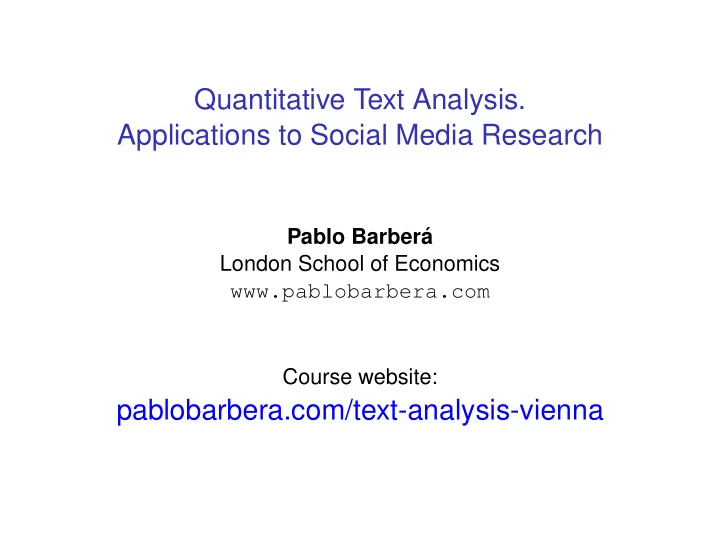

Quantitative Text Analysis. Applications to Social Media Research Pablo Barber´ a London School of Economics www.pablobarbera.com Course website: pablobarbera.com/text-analysis-vienna
Twitter data
Twitter APIs Two different methods to collect Twitter data: 1. REST API: ◮ Queries for specific information about users and tweets ◮ Search recent tweets ◮ Examples: user profile, list of followers and friends, tweets generated by a given user (“timeline”), users lists, etc. ◮ R library: tweetscores (also twitteR, rtweet) 2. Streaming API: ◮ Connect to the “stream” of tweets as they are being published ◮ Three streaming APIs: 2.1 Filter stream: tweets filtered by keywords 2.2 Geo stream: tweets filtered by location 2.3 Sample stream: 1% random sample of tweets ◮ R library: streamR Important limitation: tweets can only be downloaded in real time (exception: user timelines, ∼ 3,200 most recent tweets are available)
Anatomy of a tweet
Anatomy of a tweet Tweets are stored in JSON format: { "created_at": "Wed Nov 07 04:16:18 +0000 2012", "id": 266031293945503744, "text": "Four more years. http://t.co/bAJE6Vom", "source": "web", "user": { "id": 813286, "name": "Barack Obama", "screen_name": "BarackObama", "location": "Washington, DC", "description": "This account is run by Organizing for Action staff. Tweets from the President are signed -bo.", "url": "http://t.co/8aJ56Jcemr", "protected": false, "followers_count": 54873124, "friends_count": 654580, "listed_count": 202495, "created_at": "Mon Mar 05 22:08:25 +0000 2007", "time_zone": "Eastern Time (US & Canada)", "statuses_count": 10687, "lang": "en" }, "coordinates": null, "retweet_count": 756411, "favorite_count": 288867, "lang": "en" }
Streaming API ◮ Recommended method to collect tweets ◮ Potential issues: ◮ Filter streams have same rate limit as spritzer: when volume reaches 1% of all tweets, it will return random sample ◮ Good to restart stream connections regularly. ◮ My workflow: ◮ Amazon EC2, cloud computing ◮ Cron jobs to restart R scripts every hour. ◮ Save tweets in .json files, one per day.
Sampling bias? Morstatter et al, 2013, ICWSM , “Is the Sample Good Enough? Comparing Data from Twitter’s Streaming API with Twitter’s Firehose”: ◮ 1% random sample from Streaming API is not truly random ◮ Less popular hashtags, users, topics... less likely to be sampled ◮ But for keyword-based samples, bias is not as important Gonz´ alez-Bail´ on et al, 2014, Social Networks , “Assessing the bias in samples of large online networks”: ◮ Small samples collected by filtering with a subset of relevant hashtags can be biased ◮ Central, most active users are more likely to be sampled ◮ Data collected via search (REST) API more biased than those collected with Streaming API
Tweets from Korea: 40k tweets collected in 2014 (left) Korean peninsula at night, 2003 (right). Source: NASA.
Who is tweeting from North Korea? Twitter user: @uriminzok engl
Facebook data
Collecting Facebook data Facebook used to allow access to public pages’ data through the Graph API: 1. Posts on public pages and groups 2. Likes, reactions, comments, replies... Currently not available. Aggregate-level statistics available through the FB Marketing API. See the code by Connor Gilroy (UW) Access to other (anonymized) data used in published studies requires permission from Facebook or from users. Social Science One as a new model for academic partnerships with Facebook.
Recommend
More recommend